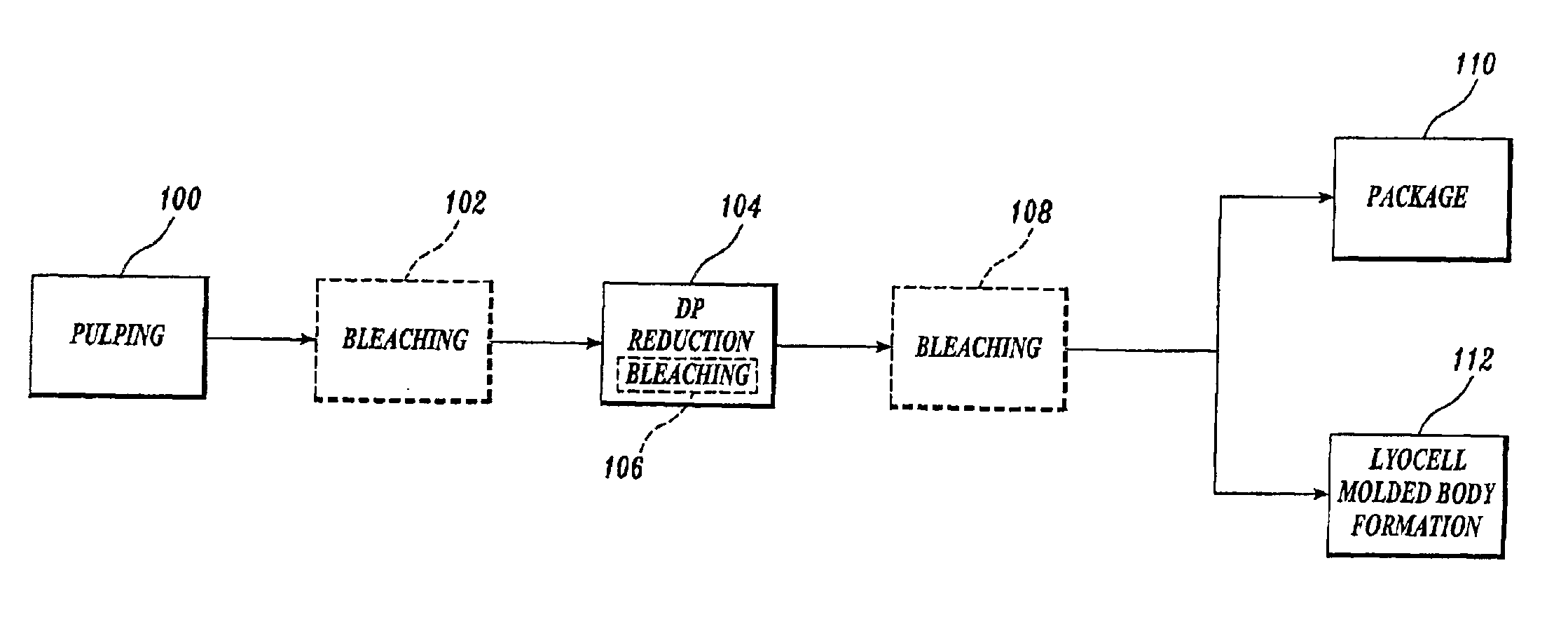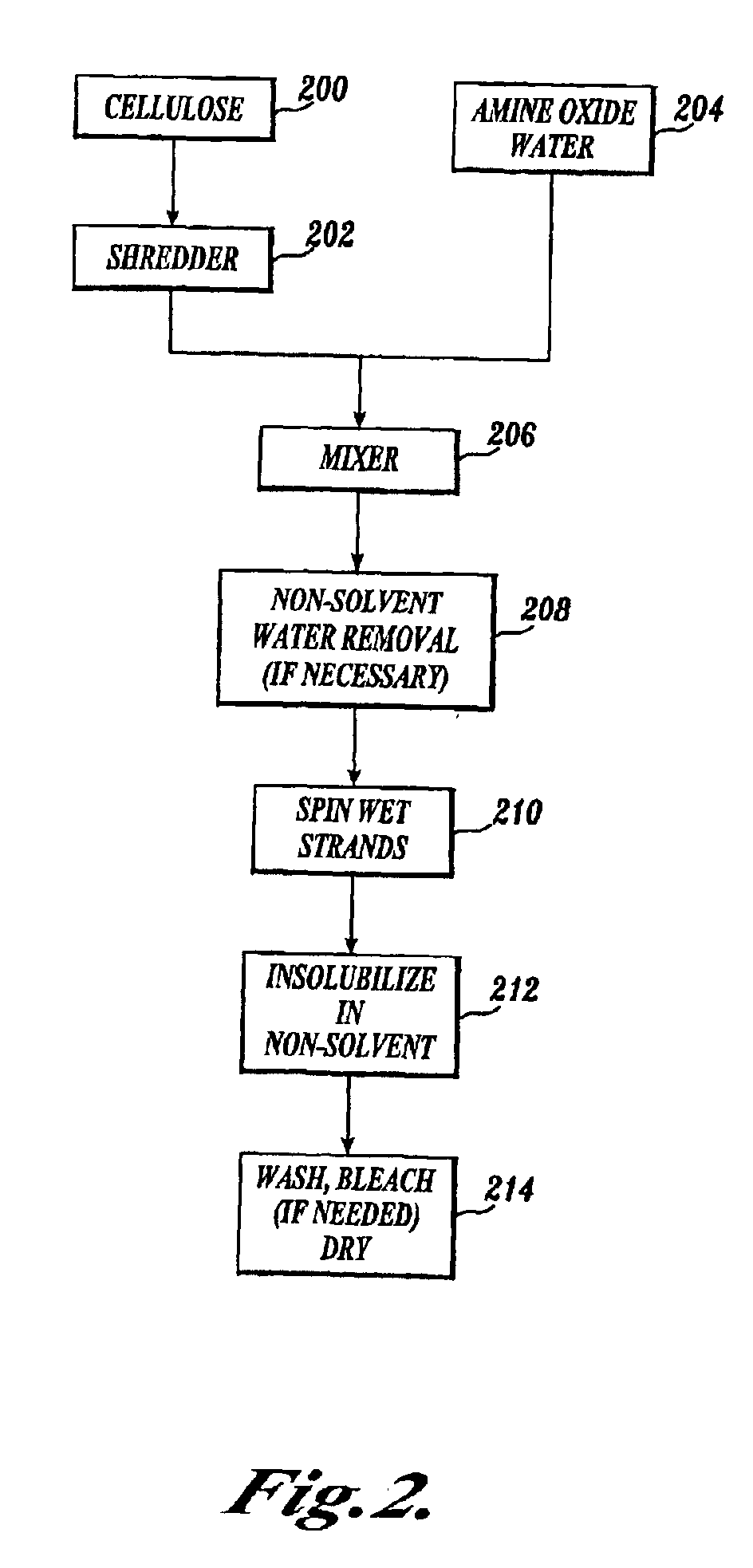Process for making lyocell fiber from sawdust pulp
a technology of lyocell fiber and sawdust pulp, which is applied in the direction of pulping with inorganic bases, melt spinning methods, transportation and packaging, etc., can solve the problems of not being able to obtain acceptable quality dissolving pulps, significantly increasing the cost of lyocell fibers and products manufactured therefrom, and increasing the cost of cellulose fibers. , to achieve the effect of reducing the average degree of polymerization of cellulose, saving landfill space, and being more economi
- Summary
- Abstract
- Description
- Claims
- Application Information
AI Technical Summary
Benefits of technology
Problems solved by technology
Method used
Image
Examples
example 1
[0104]Brownstock sawdust pulp was produced in an industrial scale M&D digester. The digester was operated at a temperature of about 182° C., and average residence time in the digester was about 60 minutes. White liquor was used as the cooking liquor in the digester. The white liquor had a total titratable alkali (TTA) of 115.2 grams per liter as Na2O, an active alkali (AA) of 99.2 grams per liter as Na2O, an effective alkali (EA) of 81.6 grams per liter as Na2O. Sulfidity of the white liquor was 28% of TTA. Specific gravity of the white liquor was 1.15.
[0105]Northern Softwood sawdust unbleached alkaline Kraft pulp (main wood species were Douglas fir, Spruce and Lodgepole pine), produced under the stated conditions, with a kappa number of 21.0 (TAPPI Standard T236 cm-85 and a viscosity of 110 cp (TAPPI T230) (D.P. of 1264), a copper number of 0.6 and a hemicellulose content of 14.1%±1.5% was treated with chlorine dioxide in a first D stage.
[0106]D1 Stage
[0107]The D1 stage treated pul...
example 2
NMMO Monohydrate Dissolution Test
[0115]In a first dissolution test with NMMO monohydrate pulp samples produced according to application Ser. No. 09 / 574,538 and the present invention, respectively, were fluffed and mixed with N-methylmorpholine-N-oxide monohydrate to provide two separate mixtures. Each of the respective mixtures was then heated on a hot plate to 85° C. and the dissolution process of the fibers in the NMMO monohydrate was observed under a light microscope of 88× magnification power. The microscope was equipped with a camera. A photograph of the respective fibers was taken when the mixture reached 85° C. FIG. 3 is a micrograph of the fiber produced according to application Ser. No. 09 / 574,538 in the solvent. FIG. 5 is a micrograph of the fiber produced according to the present invention in the solvent. Photographs were taken at time intervals of 30 seconds. FIG. 4 shows a micrograph of the prior application '538 fiber after a period of about 2 minutes. FIG. 6 shows a m...
example 3
Dry Jet Wet-Spun Fibers
[0116]The pulp made according to the present invention was used to prepare a dope sample by dissolving the treated pulp in NMMO. The dope was spun into lyocell fibers by a dry jet wet-process as described in U.S. Pat. No. 5,417,909, which is incorporated herein by reference. The dry jet wet-spinning procedure was conducted by TITK. The properties of the fibers prepared by the dry jet / wet process for the dope sample of the present invention are summarized in Table 1. Table 2 shows a comparative lyocell fiber from a pulp made by the method of application Ser. No. 09 / 574,538, also using a dry jet wet-process. The differences between the fibers of Tables 1 and 2 reside, at least, with the raw materials used in the process.
[0117]A second dissolution test was applied to the pulp samples used to make the lyocell fibers of Tables 1 and 2. The pulps were separately dissolved in NMMO at 80° C. to 100° C. to yield a 0.6% solution of cellulose without minimum stirring. Th...
PUM
| Property | Measurement | Unit |
|---|---|---|
| Fraction | aaaaa | aaaaa |
| Fraction | aaaaa | aaaaa |
| Fraction | aaaaa | aaaaa |
Abstract
Description
Claims
Application Information
 Login to View More
Login to View More - R&D
- Intellectual Property
- Life Sciences
- Materials
- Tech Scout
- Unparalleled Data Quality
- Higher Quality Content
- 60% Fewer Hallucinations
Browse by: Latest US Patents, China's latest patents, Technical Efficacy Thesaurus, Application Domain, Technology Topic, Popular Technical Reports.
© 2025 PatSnap. All rights reserved.Legal|Privacy policy|Modern Slavery Act Transparency Statement|Sitemap|About US| Contact US: help@patsnap.com



